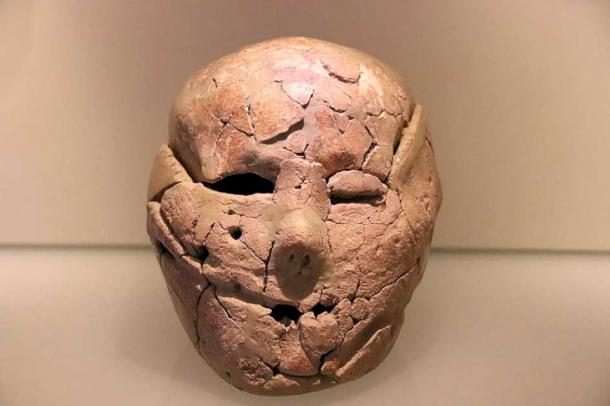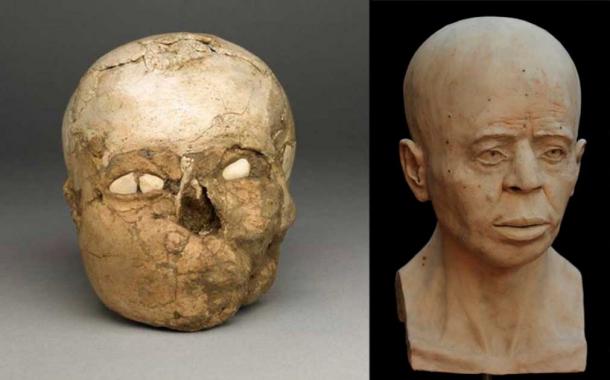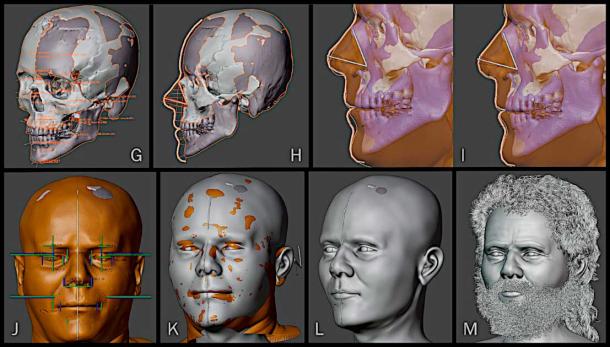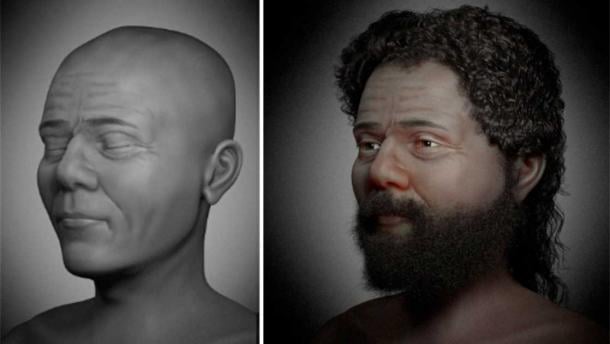
Reconstruction Reveals True Face of 9,000-Year-Old Jericho Skull
The face of the famous plastered Jericho Skull, which was found in the Palestinian city of Jericho in 1953, has been fully recreated via 3D-imaging technology, revealing exactly what the man to whom the skull belonged looked like when he walked the earth 9,000 years ago. An initial 3D re-creation of the man’s face was created in 2016, but the new image used the latest technology to produce one of the most thorough and accurate facial reconstructions ever made based on an analysis of an ancient human skull.
The Neolithic Reconstruction
Plastered skulls were a form of artwork commonly produced in the Neolithic period in the city of Jericho (Tell es-Sultan in ancient times). They were made from real human skulls that were filled in and covered with plaster, after which specific features were added to recreate the human face. The idea was to create a permanent plaster image of a living person (usually a beloved parent, grandparent, sibling or child) as a form of sculpture that could be kept around the house indefinitely.
- Bizarre Mortuary Practices and the Jericho Plastered Skulls
- Ancient Frontiers: Boundary, Defensive and Offensive Walls

A well-preserved example of a plastered skull, c. 9000 BC, found at Kfar HaHoresh in northern Israel and now at the Israel Museum in Jerusalem. (Gary Todd / CC0)
People who lived in the southern Levant (modern-day Israel and Palestine) during the Neolithic period (8,500 BC to 4,300 BC) practiced some elaborate funerary customs. They often buried their family members in graves directly beneath their homes, and in some instances they would remove the heads to make the plaster skull sculptures. These skulls were layered over with a special plaster mixture colored with iron oxide to give it a skin-like color, and the plaster was carefully shaped to make lifelike facial features (cheeks, chins, jaws, noses, etc.). Colorful shells were used to cover the eye sockets, and hair and various facial features were painted on the skulls to recreate the complete look of a living human.
Known simply as the Jericho Skull, the incredible object that was the subject of the new facial reconstruction was unearthed 70 years ago by celebrated British archaeologist Kathleen Kenyon. It was one of seven such skulls she discovered at the Tell es-Sultan site in Jericho during her excavations, which at that time were the most extensive to ever take place at that location.
This plastered skull, which in its current condition reveals only a vague outline of a decayed human face, has been held by the British Museum since its original discovery. The seven skulls that were found at the time were all sent to different museums around the world. The first such skull was discovered in the 1930s in Jericho, and as of now approximately 60 plastered skulls have been found at several sites in or around Jericho in the southern Levant.
- Face of Man Who Lived 9,500 Years Ago in Jericho Brought Back to Life
- The Ancient City of Jericho: The Oldest City in the World

The plastered Jericho skull, with the 2016 reconstruction. (British Museum)
Modern attempts at Reconstructing the 9,000-year-old Jericho Skull
The initial 2016 reconstruction was based on precise measurements of the Jericho Skull, which were obtained using a type of detailed scanning known as micro-computed tomography (micro-CT). With this data researchers were able to create a virtual 3D model of the head and face, approximating how the man would have looked when he was alive.
The new re-creation, which was released to the public in an article published in the journal OrtogOnline in December, used related but somewhat different techniques to make a more realistic and accurate version of the Neolithic man’s head and face. In this case computed tomography (CT) scans were used to harvest data from the skull, and then statistical projections of normal features and anatomical deformations were derived from those CT scan results in order to construct a more vivid and lifelike 3D image.
The team of Brazilian scientists responsible for this exceedingly accurate re-creation included individuals from three separate disciplines: 3D graphics expert Cicero Moraes, who has performed dozens of facial reconstructions of historical figures with the archaeological research group Arc-Team Brazil; dental surgeon Thiago Beaini, who is an associate professor of dentistry at the Federal University of Uberlandia; and Moacie Elias Santos, an archaeologist affiliated with the Ciro Flamarion Cardoso Archaeology Museum in the city of Ponta Grossa.
"I wouldn't say ours is an update, it's just a different approach," team leader Moraes told Live Science. But "there is greater structural, anatomical and statistical coherence" in comparison to the 2016 model.

Steps of the forensic facial approximation. (Cicero Moraes et al. /CC BY 4.0 /Ortogonline)
The new reconstruction has revealed the person to have been a dark-haired man in his 30s or 40s. By today’s standards that would have made him middle-aged. The most unusual feature of the skull was its shape, which was much broader on top and in the back than a normal human head.
Researchers know this shape was obtained through the practice of binding, where an individual’s still-forming skull is wrapped tightly in bandages at an early age to make sure it is reshaped into a particular form. This was a common practice in the Neolithic period, and it would seem it was done primarily for aesthetic purposes (because people thought oddly-shaped skulls were attractive, in other words).

Left; Final reconstruction objective facial approach. Right; Facial approximation with speculative/subjective elements eg hair, skin and eye color. (Cicero Moraes et al. /CC BY 4.0 /Ortogonline)
Getting a Closer Look at the Amazing Plaster Skulls of Ancient Jericho
Jericho, which is located 34 miles (55 kilometers) east of Jerusalem in the Palestinian West Bank, is one of the oldest inhabited cities in the world, having first been occupied around 10,000 BC. Kenyon was the first archaeologist to reach the oldest layers of settlement at Tell es-Sultan, and it was during this deep archaeological work that she found the plastered skulls. These fascinating sculptures were made in approximately 7,000 BC, and the care with which they were prepared showed just how serious the Neolithic period residents of ancient Jericho were about preserving the remains of their ancestors, in a form that could be admired and venerated by future generations.
In the Bible (the Book of Joshua), Jericho is identified as the first Canaanite city attacked by the Israelites after they crossed the Jordan River in approximately 1,400 BC. Supposedly, the walls of Jericho collapsed under an Israelite onslaught of shouting and blown trumpets, but archaeological research has failed to find any evidence to suggest any such collapse ever happened.
What archaeologists have found at Jericho, however, is some astounding artifacts that reveal the truth about the ancient funerary practices of the city’s earliest inhabitants, who were living there several thousands of years before the Israelites invaded. More and more plastered skulls have been found as excavations have continued, and in the years to come Cicero Moraes hopes to complete digital reconstructions of at least some of them, using the same techniques he applied to make the image of the Jericho Skull.
"There is a lot of mystery around this material," Moraes stated. "Thanks to new technologies we are discovering new things about the pieces, but there is still a lot to be studied."
Top image: The plastered Jericho skull, with stages of reconstruction and the final 3D image. Source: Cicero Moraes et al. /CC BY 4.0 /Ortogonline
By Nathan Falde
References
Moraes, Cicero et al. 2023. ‘ The Forensic Facial Approximation of the Skull of Jericho (BM 127414), ≈9000 BP’. Available at: https://ortogonline-com.translate.goog/doc/pt_br/OrtogOnLineMag/5/Jericho.html?_x_tr_sch=http&_x_tr_sl=pt&_x_tr_tl=en&_x_tr_hl=pt-BR&_x_tr_pto=wapp
















Comments
Yes, it would be a VERY INTERESTING analysis to compare the artist renditions to the best living match DNA. Embarrassing, no doubt, to those promoting the ‘art work’ as truth. But maybe with one of two, we say wow, odd luck? Like a blind dart-thrower hitting the bulls-eye!
But I’d bet ALL of them are way off – because as I see it (my theory), the intent is to deceive, to cover the inconvenient truth ...of the black-headed Sumerian tribes supplanting the fair-haired gentiles (aboriginals) in those lands - pattern that explains all of history. But regardless, we MUST have the pursuit of TRUTH in all its angles and understandings. Otherwise, Archaeology and Anthropology remain quack sciences.
Nobody gets paid to tell the truth.
I don't mind such reconstructions.
As long as they're right.
How often is that? It's a fair question...
I find it curious that we need to reconstruct the faces of these ancient deceased people. Why can’t we just leave them alone and appreciate them as sculptures?
For once, Mr. Wagner, I wholeheartedly agree with you.
I don’t know how they can keep getting away with such fantasy. For one, you CANNOT determine the skin, nose, cartilage or hair by the skull alone! That’s so obvious, and to pursue that is so full of imagination and dubious bias.
But as I’ve said, the best and easiest way to determine what the ancient person looked like is to simply do the DNA analysis, and match it up with the closest living person. This will tell you in a true, scientific manner, the true characteristics of facial appearance – color/texture of hair, skin, eyes, SHAPE of nose/lips – and overall physical stature, that we want to see. We do NOT care at all what, beyond shape of skull, an artist (or professor) whimsically DECIDES the person looked like.
And now for the kicker: The 3D artist who did the reconstruction gave the man the SAME hair he has! http://www.ciceromoraes.com.br/doc/pt_br/Moraes/_images/20180711_01.jpg Unbelievable? So ridiculous!
Nobody gets paid to tell the truth.